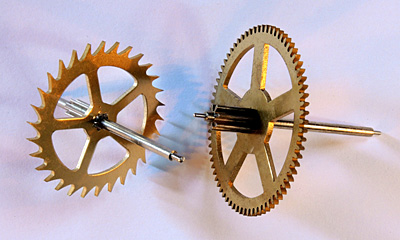Packing instructions for Kieninger wall – regulator, spring driven.
Just a few points to consider. Remove the pendulum by lifting it a few millimeters up and take it out of the pendulum leader ( flat brass part )
Then fold some paper or soft packing foam sheet into square of about 80 mm. The final thickness should be about 10 to 15 mm. As long as it is a bit compressible.
One also could use a few of these round cosmetic cotton pads, wrapped into a plastic cover.
Slide the paper/plastic between the base of the brass holder and the black gong. That is to prevent the coil gong from vibrating, making a noise and possible breaking. ( Much more important with gong rods, though ).
You could do that either with the clock on the wall or when it lies flat on a table.
The other moving part is the pendulum leader. That is the flat brass part with an open end and the square hole section into which the pendulum hooks.
To prevent that from moving to and fro, estimate the space between the wooden back and that brass part. Make a crunched ball of newspaper or soft wrapping (bubble wrap) and stick it carefully between back wall and the pendulum leader, which will be touching the back plate now. If you use newspaper, insert it into a plastic bag. (Paper could possibly absorb some oil from the three bearings near the bottom of the movement.)
Stopping the pendulum leader prevents possible ticking of the clock and releasing the strike.
Wrap the pendulum with bubble wrap or any soft non-fluffy material and lay it diagonally into the bottom part of the clock. Make sure there is enough packing around the sharp tip of the pendulum.
If you crunch up some more newspaper and fill the 2/3 part of the clock, that will also just reach under the dial and prevent the small crunched ball to loosen from its position.
Wrap the clock with some expanded foam- or bubble-wrap material.
Packing the complete clock into a box, which should have extra space of 50 to 100 mm all round, also bottom of box and on top , (depending on mode of transport). Crunch up old newspaper into loose balls and make a “bed”. Put the clock onto that and check that there is enough space left on top as well. ( On does not know, in which position the box gets turned with handling )
Crunched newspaper is simply the best shock absorber. Bubble wrap is good as well, preferably small bubbles and the pieces crunched up in addition. I prefer the newspaper method, though.
Thomas Niemeyer, May 2018


